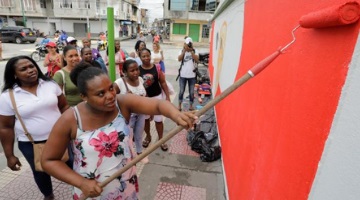Vive la Educación! Improving access to education for Colombian kids

Colombian girls at school. Photo: Save the Children Colombia.
A new education model is helping vulnerable Colombian kids return to the classroom.
In 2016, Colombia’s 50-year internal conflict ended with the signing of a peace agreement between the Revolutionary Armed Forces of Colombia’s People’s Arm (FARC-EP) and the Colombian government. As Colombia looks ahead to a more peaceful future, support for children affected by the conflict is critical.
Violence completely changed the lives of many children. Colombian children were forced out of school when teachers and schools risked becoming the targets of gunfire, landmines and other explosive devices.
Literacy rates declined, as well as chances of employment later on in life. Without safe school environments, many children were vulnerable to recruitment by armed groups.
The lack of education worsened inequalities for Afro-Colombian children. They were disproportionately affected by the armed conflict in Colombia, and continue to experience discrimination.
The Embassy of Canada to Colombia is committed to working with partners to improve education for Colombian kids, starting with a new education model.
Getting kids back to school

Alongside Save the Children and the Norwegian Refugee Council, Canada is supporting “Vive la Educación,” a project that makes school more inclusive and accessible in areas that are most affected by conflict.
Around 145,000 children now benefit from psychological support and after-school programs, giving them the support they need to process what they experienced. Teachers have reported higher attendance and students who were previously out of school are now reintegrated into the school system.
Bridging the gap for Afro-Colombian students

Another essential part of “Vive la Educación” is an ethno-education model for Afro-Colombian students.
The model addresses the specific needs of Afro-Colombian children in order to close the educational gap. It aims to reduce Afro-Colombian illiteracy rates and encourage women and girls to participate in planning and achieving their education.
"This model has allowed us to strengthen our knowledge as teachers, empower the education community and re-affirm the cultural values of Afro-Colombian communities."
The “Vive la Educación” ethno-education approach is widely recognized by Colombian communities and government authorities. Different provinces are now developing their own ethno-educational policies based on the project’s model. Colombia’s Ministry of Education is also financing its expansion to other provinces.
The ethno-education model is currently being transferred to the Colombian government, so that they can implement it on a larger scale.
Fostering long-term sustainable development

The model, selected for a government initiative called “Exchange Colombia-Colombia”, features local, innovative approaches to promoting peace.
In collaboration with Colombia’s Presidential Agency for International Cooperation and Colombia’s Ministry of Education, the Embassy of Canada to Colombia recently hosted an “Exchange Colombia-Colombia” event in the conflict-affected municipality of Tumaco (South-west Colombia).
More than 30 representatives from six different regions of Colombia with significant Afro-Colombian communities participated in the 3-day workshop. They learned about the benefits and components of the Canada-funded ethno-education model.
The workshop asked participants to consider how the model could be used in their communities. Participants plan to hold further discussions about improving and implementing this model across the country.
"Only by recovering our ancestral traditions and knowledge we will be able to progress and turnover the page of violence. With this model we are able to create an education of our own, that responds to our realities and needs."
In addition, William Valencia, Secretary of Education from Tumaco (province of Nariño) said, "The ethno-education model helped us understand our needs as local governments and strengthen our social tissue in conflict-affected territories."
Building a brighter future starts with kids

Canada knows that education is not only a human right, but also the foundation for sustainable development. When boys and girls receive a quality education, they can break the poverty cycle, living healthier and more peaceful lives.
Education is crucial for reducing poverty, achieving gender equality and fostering economic growth and social development. Education is particularly important for communities in Colombia as they rebuild their lives after the conflict.
As part of the 2030 Agenda for Sustainable Development, Canada remains dedicated to a world where everyone has access to education.
When all children have access to quality education, the world’s future is bright.
- Date modified:


